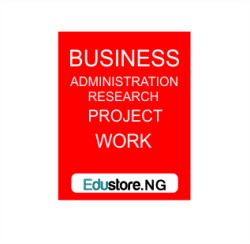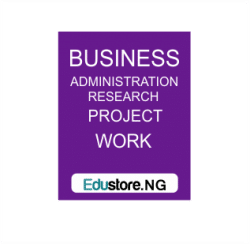CHAPTER ONE
INTRODUCTION
1.1 BACKGROUND INFORMATION
The impact of industrialization is felt in a variety of ways. Setting up a new plant will have a repercussion on the local economy through the acquisition of inputs, the disposal of outputs and the generation of income. If may also effect the physical environment through site construction, the generation of affluence, and so on.
In addition there is human social or cultural impact as the lives of local people changed for better or worse. We shall examine, environmental and social or cultural impact in-turn and then on the conclude with an integrated perspective based on the concept of general welfare.
We shall consider both the identification of impact and the question of how particular patterns of impact can be achieved.
Until the letter part of the 1960s the impact of industrialization was viewed very much in economic times. With the background of the depression of the 1930s and the build-up of the postwar era of economic growth, the planning of industrial location was seen largely as a means of bringing the material benefits of the affluent society to localized pockets of poverty such as in Appalachia and in the northern regions of Britain.
But the attainment of high levels of material wellbeing eventually encouraged people to take a broader view of the effects of rapid economic growth on the quality of the embarrassment. In Akwa Ibom State, the increasing concern “Pollution” culminated in the national environmental impact policy act of 1969, which required the preparation of an environmental impact statement by federal government to support any policy or propose action. This, together with similar measures in other countries has focused the attention of scholars on the problem of the precise assessment of environmental impact as a matter of special relevance to the geographer’s traditional concern with man- (Whitem 1972) (O Rio Dan, 1972), (Greenberge, Anderson, page 1978).
Industrialization has taken on a very broad meaning in recent years. This is illustrated in Akwa Ibom State, (Nigeria) report on environmental impact analysis, which recognizes five major impact groups along with various subdivisions. This classification incorporates some of what we have considered as economic impact, and which extends into the social and cultural realms. It helps to reveal how intensive the impact of economic development can be as well as complexity of the task of preparing a industrial development, the identification of the optimum location with respect to environmental impact would involve a complete description of the likely under all the categories indicated, together with the same information for all practical alternative locations.
The focus of this paper is therefore, to investigate the impact of industrialization on Akwa Ibom State’s development using peacock paints ltd as a case study.
1.2 BRIEF HISTORY OF PEACOCK PAINT LIMITED
Peacock paint company (Nigeria) limited, Ikot Ekan, Etinan was established as Cross River State paint limited in 1979. The company started production in 1984. And got commissioned on 11th April 1986 it had on initial authorized share capital of N1.5 million: this was increased to N3.3 million in 1983 and the. Then N40 million in 1996.
The company is owned 22.9 percent by overseas partners comprising 5-Drup-Technical partner from Denmark and international fund for develop countries.
Investments trust company and manila insurance company jointly holds 39.9 percent equity, indigenous businessmen, hold 32 percent, while the company employee owned 5.2 percent equity holding.
THE COMPANY’S OBJECTIVES INCLUDE:
- To manufacture and sell assorted types of paint and varnish at a profit.
- To provide employment for indigenes.
iii. To help in developing the local communities.
TYPES OF PAINTS MANUFACTURED INCLUDE:
Emulsion paint, gloss paint, thinner, peacocked (textured emulsion). Carlux cautobases selid and metallic I, and wood vanish. Organizational structure of the company has the shareholders as the supreme body, which annually elects a board of directors to formulate the policies of the company.
It then follows by the managing director who is assisted by three assistant general managers and (A.G.M). these include A.G.A, finance and Administration to take cane of employee and labour matters, employee training and development, budgets and planning. Annual accounts and reports. AGM marketing and sales to take cane of sales and marketing matters and AGM operations research and development including new product development, maintenance, safety and security, the operations department includes works, production and quality control. The motto of the company is “Quality with pride”.
1.3 STATEMENT OF THE PROBLEM
In-spite of the number of industries in Akwa Ibom State, it has been statistically observed that they have not actually done well in the area of economic development. The most form of economic impact analysis is based on the Keynesian concept of the multiplier. This concerns itself with the way in which an initial increase in income from one source will multiply by stimulating the generation of further income in other activities. The identification of a local or regional multiplier effect involves the estimation of how much additional local or regional income will arise from an initial expansion in local or regional income generating activity. If a new plant is setup or an existing industry expands, local or regional income will increase initially to the extent that he additional output is sold elsewhere or exported (for local sales generate no net addition to local income).
DOWNLOAD COMPLETE WORK- For Reference Only: Materials are for research, citation, and idea generation purposes and not for submission as your original final year project work.
- Avoid Plagiarism: Do not copy or submit this content as your own project. Doing so may result in academic consequences.
- Use as a Framework: This complete project research material should guide the development of your own final year project work.
- Academic Access: This platform is designed to reduce the stress of visiting school libraries by providing easy access to research materials.
- Institutional Support: Tertiary institutions encourage the review of previous academic works such as journals and theses.
- Open Education: The site is maintained through paid subscriptions to continue offering open access educational resources.






